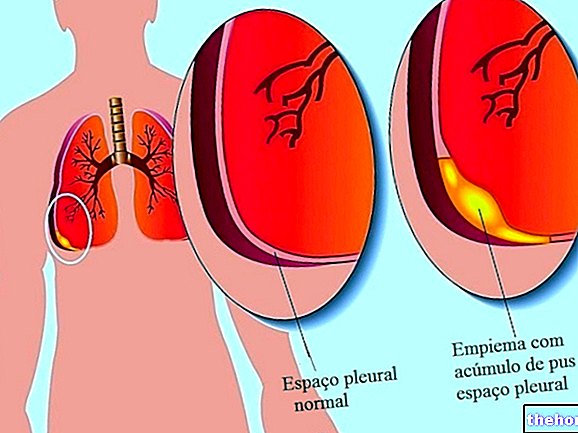1) Department of Internal Medicine, Athena Villa dei Pini Clinic, Piedimonte Matese (CE);
Introduction
The cyclist significantly and constantly engages the respiratory system, in the peculiar function of greater supply of oxygen and the removal of carbon dioxide produced by the increase in muscle activity.
The pathologies of the respiratory system that are most frequently observed in cyclists are infections, acute and chronic, of viral or bacterial origin, and exercise-induced bronchial asthma.
Infectious diseases

Causes
A decisive role for the onset of respiratory tract infections is played by the decrease in the immune defenses.
It has been known for over a century that lymphocytes are activated in the blood before and after exercise; however, the concentration of lymphocytes is significantly reduced at the end of the effort. In the post-exercise phase there is therefore a generalized decrease in the activity of the immune system; this phenomenon, called "open window", is detectable in various conditions of physical stress, such as an intense training session or a competition.
During the "open window" phase, the subject is particularly exposed to the risk of infections. For a cyclist it is easy to imagine how this phase corresponds to a moment in which the possibility of contact with pathogens is particularly high: immediately after a race, in fact, the embrace of the fans, the stay in the hospitality facilities together with other people, the water vapor showers and the air conditioning of rooms or means of transport represent an optimal vehicle for the transmission of infectious agents.
A transient deficit of immune function increases the risk of contracting respiratory infections, especially of viral origin.
Symptoms
Manifestations generally consist of local symptoms, such as nasal congestion, pharyngodynia, rhinorrhea, and systemic symptoms, such as fever, headache, asthenia and myarthralgia. These infections, generally limited to the supralaryngeal structures, can also affect the lung structure, with the appearance of tracheitis and / or tracheo-bronchitis.
Diagnosis and Treatment
The diagnosis is given by the clinical examination: tracheitis rarely presents objective signs, while bronchitis can be characterized by mucopurulent sputum and by pathological noises that are widespread on hearing, such as snoring, rales and wheezing.
Therapy is symptomatic, with recourse to antibiotic treatment only in case of bronchitis with purulent sputum. In order to prevent complications, a short break from sports activities for 2 or 3 days is recommended.
Exercise Asthma
Bronchial asthma, considered a reversible obstructive inflammation of the airways, is a pathology characterized by bronchial hyper-reactivity, which can be induced or worsened by physical activity.
Causes
Endurance physical exercise, such as cycling, can cause a more or less marked increase in the resistance of the airways, with consequent difficulty in breathing of varying intensity and duration.
In predisposed athletes, the increased frequency of breathing (hyperpnea) during exercise is the trigger for the onset of bronchospasm (reduction in volume of the respiratory bronchioles). Hyperpnea induces a cooling of the bronchial mucosa, which a in turn it determines an "initial vasoconstriction of the peribronchial capillaries; during the pause, on the other hand, there is an overflow of blood in these vessels, with hyperemia and edema of the mucosa, and consequent narrowing of the bronchial lumen.
For what has been said, the higher the ventilatory level required by sporting activity, the greater the risk of bronchospasm; as an essential factor, obviously, there is always the "bronchial hyperreactivity induced by" chronic inflammation.
Favorable factors are climatic and environmental conditions; for example, the colder and drier the inhaled air, the greater the risk of bronchospasm. The presence of pollutants or allergens can also promote bronchial constriction.
Prevention
Today cyclists and athletes in general tend to underestimate some symptoms, instead worthy of attention due to the risk of chronic respiratory disease. Very often, for example, a banal flu accompanied by sore throat and low-grade fever is neglected by the athlete, who returns to the saddle with the immune defenses still committed to fighting the viral infection, exposing himself to the risk of overlapping an infection. bacterial.
Preventing diseases of the respiratory system is simple, just follow some simple precautions:
- when it is cold outside, go out for physical exercise well covered, with suitable technical material:
- allergy sufferers must consult the health care provider to use specific drugs;
- those who train throughout the winter season must pay attention to the arrival of spring, when they must abandon heavy jackets, in fact in this period of the year there is the highest risk of viral infection;
- if you run into a flu, stop the activity and only resume it when you are clinically recovered
- if the cough persists, consult your doctor
- drink plenty of fluids while exercising
- vaccination is recommended for those subjects who, on time, during the winter-spring period get sick, with high fever and respiratory complications
- the intake of a multivitamin preparation is recommended.
Prevention is better than cure, so cyclists and athletes in general need to know what they are going through if they go over the line by asking too much of their body.
The human machine lives in perfect balance; if we demand more, the immune system decreases its protective function, making the organism more vulnerable to infections.
By Correspondence: Dr. Luigi Ferritto
Department of Internal Medicine Clinical Respiratory Physiopathology Unit "Athena" Villa dei Pini
Piedimonte Matese (CE)





























